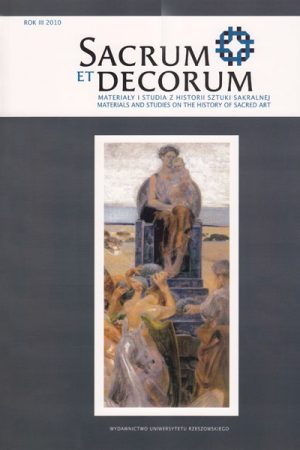The Truth of the Model and Jacek Malczewski’s Crucifixions
Keywords:
BOBOWA, CRUCIFIXION, JACEK MALCZEWSKI, OLESNOAbstract
Jacek Malczewski's paintings often deal with biblical subjects, but strictly sacred pictures, i.e. intended for worship, are in his work very rare. When discussing the artist's faith, it should be mentioned that apart from the habit of prayer he learnt at home, as a young man he was a member of St. Vincent de Paul Society encouraging not only charity work, but also systematic reading of the Old and New Testament and other spiritual texts. The two Crucifixions painted by Malczewski are similar in their composition (the first one, from the family chapel belonging to the Konopkas of Bren at St Catherine's Church in Olesno, known only from photographs, was painted in 1898; the other, in All Saints Church in Bobowa was painted around 1903). The documentation presented in the article helps to recreate the circumstances of making of both pictures and their dating. The author confronts the character of the Crucifixions with the 'optimistic' subjects recommended for general church teaching, such as the Virgin Mary and the cult of the Sacred Heart of Jesus, stressing the hope for salvation. The way the Bobowa Crucifixion is painted emphasizes the expressionistic, cadaverous features of Jesus's body. The model was a suicide, whose body was set in the appropriate pose by the artist in the autopsy room at the Department of Anatomy in the Unit of Forensic Medicine, whose head, Prof. L. Wachholtz was Malczewski's friend. The traces of this model are clearly visible in the Bobowa picture - the vertical beam of the cross has a crack identical to the crack in desk supporting the suicide's body in the photograph. Other visible elements are the wire stuck into the arm and the pegs under the armpits, supporting the body and helping to place the body in the position appropriate for forensic photography. The perversity of this concept (the suicide, judged by the standards of these times, juxtaposed with the physicality of God-man and its results) has much in common with the contemporary literature which used often hyperbolic monumentalization. Such an approach to this subject was, however, hard to swallow both for the provincial parish priest and his parishioners, and for that reason the painting was removed from the main altar.Downloads
Downloads
Published
How to Cite
Issue
Section
License
Copyright (c) 2010 Sacrum et Decorum

This work is licensed under a Creative Commons Attribution-NonCommercial-NoDerivatives 4.0 International License.
In line with the Open Access policy, authors retain full copyright to their articles – without restrictions.
Authors can deposit their articles in a repository of their choice.


